A Study on the Coupling and Coordination Between Urban Economic Resilience and High-Quality Development of Tourism in the Yangtze River Economic Belt
Abstract
1. Introduction
2. Literature Review
3. Overview of the Research Area and Data Sources
3.1. Overview of the Research Area
3.2. Data Sources
4. Research Framework and Methodology
4.1. The Coupling and Coordination Mechanism Between ER and HQTD
4.2. Measurement Indicators for the Coupling Coordination Between ER and HQTD
4.3. Research Methodology
4.3.1. Comprehensive Evaluation Model
4.3.2. Collinearity Test
4.3.3. Coupling Coordination Model
4.3.4. Gini Coefficient
4.3.5. Kernel Density Estimation
4.3.6. Global Spatial Autocorrelation
4.3.7. Influence Coordination Force Index
5. Analysis of Results
5.1. Characteristics of ER Development
5.2. HQTD Characteristics
5.3. Characteristics of the Spatio-Temporal Evolution Analysis of the CCD of ER and HQTD in the YREB
5.3.1. Description of the Progression over Time
5.3.2. Spatial Evolution Characteristics
5.3.3. Global Spatial Autocorrelation Analysis
5.4. Kernel Density Estimation Analysis
5.5. Influence Coordination Force Analysis
6. Discussion, Policy Recommendations, and Study Limitations
6.1. Discussion
6.2. Policy Recommendations
6.3. Study Limitations
7. Conclusions
Author Contributions
Funding
Data Availability Statement
Conflicts of Interest
References
- Sharifi, A.; Allam, Z.; Bibri, S.E.; Khavarian-Garmsir, A.R. Smart cities and sustainable development goals (SDGs): A systematic literature review of co-benefits and trade-offs. Cities 2024, 146, 104659. [Google Scholar] [CrossRef]
- Wu, D.; Liu, W.; Ren, Y.; Li, H. Exploring energy and tourism economy growth nexus with DEA-based index systems: The case of sustainable development of tourism destinations. Environ. Sci. Policy 2024, 160, 103858. [Google Scholar] [CrossRef]
- Zeigermann, U.; Uçaray Mangıtlı, B. Knowledge representation in global environmental assessments-Patterns among authors of the Global Environmental Outlook. Environ. Sci. Policy 2025, 164, 104004. [Google Scholar] [CrossRef]
- Filipović, S.; Lior, N.; Radovanović, M. The green deal–just transition and sustainable development goals Nexus. Renew. Sustain. Energy Rev. 2023, 168, 112759. [Google Scholar] [CrossRef]
- Hossain, M.R.; Rao, A.; Sharma, G.D.; Dev, D.; Kharbanda, A. Empowering energy transition: Green innovation, digital finance, and the path to sustainable prosperity through green finance initiatives. Energy Econ. 2024, 136, 107736. [Google Scholar] [CrossRef]
- Li, M.; Wang, J.; Dong, Y.; Zeng, Y.; Shen, N.; Liu, W. What combinations drive the urban green infrastructure development in China’s Yangtze River Economic Belt? An empirical study based on fs/QCA. Ecol. Indic. 2024, 166, 112190. [Google Scholar] [CrossRef]
- Du, Y.; Wang, Q.; Zhou, J. How does digital inclusive finance affect ER: Evidence from 285 cities in China. Int. Rev. Financ. Anal. 2023, 88, 102709. [Google Scholar] [CrossRef]
- Han, S.; Wang, H.; Ao, Y.; Wang, B.; Chen, B.; Martek, I. Resilient city construction efficiency and its influencing factors in China’s Chengdu-Chongqing Economic Circle: Considering both construction input and resilience level of the city. Sustain. Cities Soc. 2024, 114, 105726. [Google Scholar] [CrossRef]
- Cheng, X.; Ge, F.; Xu, M.; Li, Y. The heat island effect, digital technology, and urban ER: Evidence from China. Technol. Forecast. Soc. Change 2024, 209, 123802. [Google Scholar] [CrossRef]
- Ribeiro, P.J.G.; Gonçalves, L.A.P.J. Urban resilience: A conceptual framework. Sustain. Cities Soc. 2019, 50, 101625. [Google Scholar] [CrossRef]
- Li, Q.; Wang, X.; Chen, Z.; Arif, M. Assessing the conjunction of environmental sustainability and tourism development along Chinese waterways. Ecol. Indic. 2024, 166, 112281. [Google Scholar] [CrossRef]
- Yuan, Z.; Hu, W. Urban resilience to socioeconomic disruptions during the COVID-19 pandemic: Evidence from China. Int. J. Disaster Risk Reduct. 2023, 91, 103670. [Google Scholar] [CrossRef]
- Yang, T.; Yu, N.; Hong, T. How do urban socio-economic characteristics shape a city’s social recovery? An empirical study of COVID-19 shocks in China. Int. J. Disaster Risk Reduct. 2023, 90, 103643. [Google Scholar] [CrossRef]
- Zhang, C.; Zhao, L.; Song, X.; Zhang, Q.; Zhang, X. Spatial-temporal coupling characteristics and interaction effects of economic resilience and people’s livelihoods and well-being: An analysis of 78 cities in the Yellow River Basin. Sustain. Cities Soc. 2024, 112, 105638. [Google Scholar] [CrossRef]
- Tang, J.; Zhao, P.; Gong, Z.; Zhao, H.; Huang, F. Resilience patterns of human mobility in response to extreme urban floods. Natl. Sci. Rev. 2023, 10, nwad097. [Google Scholar] [CrossRef]
- Lv, W.; Fan, W.; Wang, Z. How to enhance the resilience of domestic tourism? J. Hosp. Tour. Manag. 2024, 61, 165–177. [Google Scholar] [CrossRef]
- Wang, M.; Su, M.M.; Gan, C.; Yu, Z. A coordination analysis on tourism development and resident well-being in the Yangtze River Delta Urban Agglomeration, China. J. Clean. Prod. 2023, 421, 138361. [Google Scholar] [CrossRef]
- Zhang, X.; Guo, W.; Bashir, M.B. Inclusive green growth and development of the high-quality tourism industry in China: The dependence on imports. Sustain. Prod. Consum. 2023, 29, 57–78. [Google Scholar] [CrossRef]
- Zheng, X.; Yang, Z. Coordination or contradiction? The spatiotemporal relationship between ecological environment and tourism development within the tourism ecological security framework in China. Ecol. Indic. 2023, 157, 111247. [Google Scholar] [CrossRef]
- Li, S.; Sun, Y. Tourism development and residents’ well-being: Analysis of top ten tourist destinations using quantile-on-quantile approach. J. Destin. Mark. Manag. 2025, 36, 100977. [Google Scholar] [CrossRef]
- Yang, X.; Ran, G. Factors influencing the coupled and coordinated development of cities in the Yangtze River Economic Belt: A focus on carbon reduction, pollution control, greening, and growth. J. Environ. Manag. 2024, 370, 122499. [Google Scholar] [CrossRef]
- Chau, N.M.; Anh, D.N.C.; Trang, N.M.; Luong, B.V. Economic resilience and sustainable tourism development: Analyzing domestic visitors’ behaviors at religious attractions in Vietnam. In Proceedings of the 12th International Conference on Emerging Challenges: Sustainable Strategies in the Data-Driven Economy (ICECH 2024), Thanh Hoa, Vietnam, 1–2 November 2024. [Google Scholar] [CrossRef]
- Greiner, R. Improving the Net Benefits from Tourism for People Living in Remote Northern Australia. Sustainability 2010, 2, 2197–2218. [Google Scholar] [CrossRef]
- Lin, Y.; Peng, C.; Chen, P.; Zhang, M. Conflict or synergy? Analysis of economic-social-infrastructure-ecological resilience and their coupling coordination in the Yangtze River economic Belt, China. Ecol. Indic. 2023, 142, 109194. [Google Scholar] [CrossRef]
- Liu, M.; Lu, M.; Li, Z. Coupling coordination analysis on digital economy-tourism development-ecological environment. J. Clean. Prod. 2024, 470, 143320. [Google Scholar] [CrossRef]
- Fan, M.; Wang, Y.; Ye, S.; Wei, C.; Xue, Z. The Spatial Network Characteristics of the Coupling Coordination Degree Between Pollution and Carbon Reduction and HQD in the Yangtze River Economic Belt. Land 2024, 13, 2102. [Google Scholar] [CrossRef]
- Zhang, L. Influence of cultural heritage protection on high-quality economic development. Financ. Res. Lett. 2025, 76, 106932. [Google Scholar] [CrossRef]
- Machado, J.T.M.; de Andrés, M. Implications of offshore wind energy developments in coastal and maritime tourism and recreation areas: An analytical overview. Environ. Impact Assess. Rev. 2023, 99, 106999. [Google Scholar] [CrossRef]
- Shahzad, U.; Tiwari, S.; Si Mohammed, K.; Zenchenko, S. Asymmetric nexus between renewable energy, economic progress, and ecological issues: Testing the LCC hypothesis in the context of sustainability perspective. Gondwana Res. 2024, 129, 465–475. [Google Scholar] [CrossRef]
- KC, B.; Dhungana, A.; Dangi, T.B. Tourism and the sustainable development goals: Stakeholders’ perspectives from Nepal. Tour. Manag. Perspect. 2021, 38, 100822. [Google Scholar] [CrossRef]
- Pan, S.-Y.; Gao, M.; Kim, H.; Shah, K.J.; Pei, S.-L.; Chiang, P.-C. Advances and challenges in sustainable tourism toward a green economy. Sci. Total Environ. 2018, 635, 452–469. [Google Scholar] [CrossRef]
- Sun, Y.; Ding, W.; Yang, G. Green innovation efficiency of China’s tourism industry from the perspective of shared inputs: Dynamic evolution and combination improvement paths. Ecol. Indic. 2023, 138, 108824. [Google Scholar] [CrossRef]
- Zeng, H.; Chau, K.Y.; Waqas, M. Does green finance and renewable energy promote tourism for sustainable development: Empirical evidence from China. Renew. Energy 2023, 207, 660–671. [Google Scholar] [CrossRef]
- Wang, H.; Li, Y.; Liu, Y.; Qing, F.; Zhou, Y.; Chen, Y.; Fang, D. Study on the Influencing factors of urban ER in post epidemic Era—A case study of Kunming City. J. Urban Manag. 2021, 10, 255–264. [Google Scholar] [CrossRef]
- Zhai, X.; Sun, C.; Zou, W.; Hao, S. Spatiotemporal characteristic and evolution of China’s marine ER. Ocean. Coast. Manag. 2023, 238, 106562. [Google Scholar] [CrossRef]
- Wang, J.; Zhou, X. Measurement and synergistic evolution analysis of ER and green economic efficiency: Evidence from five major urban agglomerations, China. Appl. Geogr. 2024, 168, 103302. [Google Scholar] [CrossRef]
- Jiang, N.; Jiang, W.; Wang, Y.; Zhang, J. Impact of financial reform on urban resilience: Evidence from the financial reform pilot zones in China. Socio-Econ. Plan. Sci. 2024, 94, 101962. [Google Scholar] [CrossRef]
- Zhang, Y.; Li, Y.; Wei, X.; Yang, Y.; Liu, L.; Murphey, Y.L. Graph matching for knowledge graph alignment using edge-coloring propagation. Pattern Recognit. 2023, 144, 109851. [Google Scholar] [CrossRef]
- Vu, D.H.; Muttaqi, K.M.; Agalgaonkar, A.P. A variance inflation factor and backward elimination based robust regression model for forecasting monthly electricity demand using climatic variables. Appl. Energy 2015, 140, 385–394. [Google Scholar] [CrossRef]
- Dong, Q.; Zhong, K.; Liao, Y.; Xiong, R.; Wang, F.; Pang, M. Coupling coordination degree of environment, energy, and economic growth in resource-based provinces of China. Resour. Policy 2023, 81, 103308. [Google Scholar] [CrossRef]
- Wu, B.; Quan, Q.; Yang, S.; Dong, Y. A social-ecological coupling model for evaluating the human-water relationship in basins within the Budyko framework. J. Hydrol. 2023, 619, 129361. [Google Scholar] [CrossRef]
- Yu, T.; Zhang, Y.; Jia, S.; Cui, X. Spatio-temporal evolution and drivers of coupling coordination between digital infrastructure and inclusive green growth: Evidence from the Yangtze River economic belt. J. Environ. Manag. 2025, 376, 124416. [Google Scholar] [CrossRef]
- Yang, L.; Lin, Y.; Zhu, J.; Yang, K. Dynamic coupling coordination and spatial–temporal analysis of digital economy and carbon environment governance from provinces in China. Ecol. Indic. 2023, 156, 111091. [Google Scholar] [CrossRef]
- Kang, Y.; He, S.; Ni, T.; Cao, Z.; Wu, G. Temporal-spatial evolution and coupling analysis of water-energy-carbon nexus for crop production: A case study of Sichuan Province, China. Energy Nexus 2025, 20, 100542. [Google Scholar] [CrossRef]
- Gocer, O.; Boyacioglu, D.; Karahan, E.E.; Shrestha, P. Cultural tourism and rural community resilience: A framework and its application. J. Rural. Stud. 2024, 107, 103238. [Google Scholar] [CrossRef]
- Szromek, A.R.; Herman, K.; Naramski, M. Sustainable development of industrial heritage tourism—A case study of the Industrial Monuments Route in Poland. Tour. Manag. 2021, 83, 104252. [Google Scholar] [CrossRef]


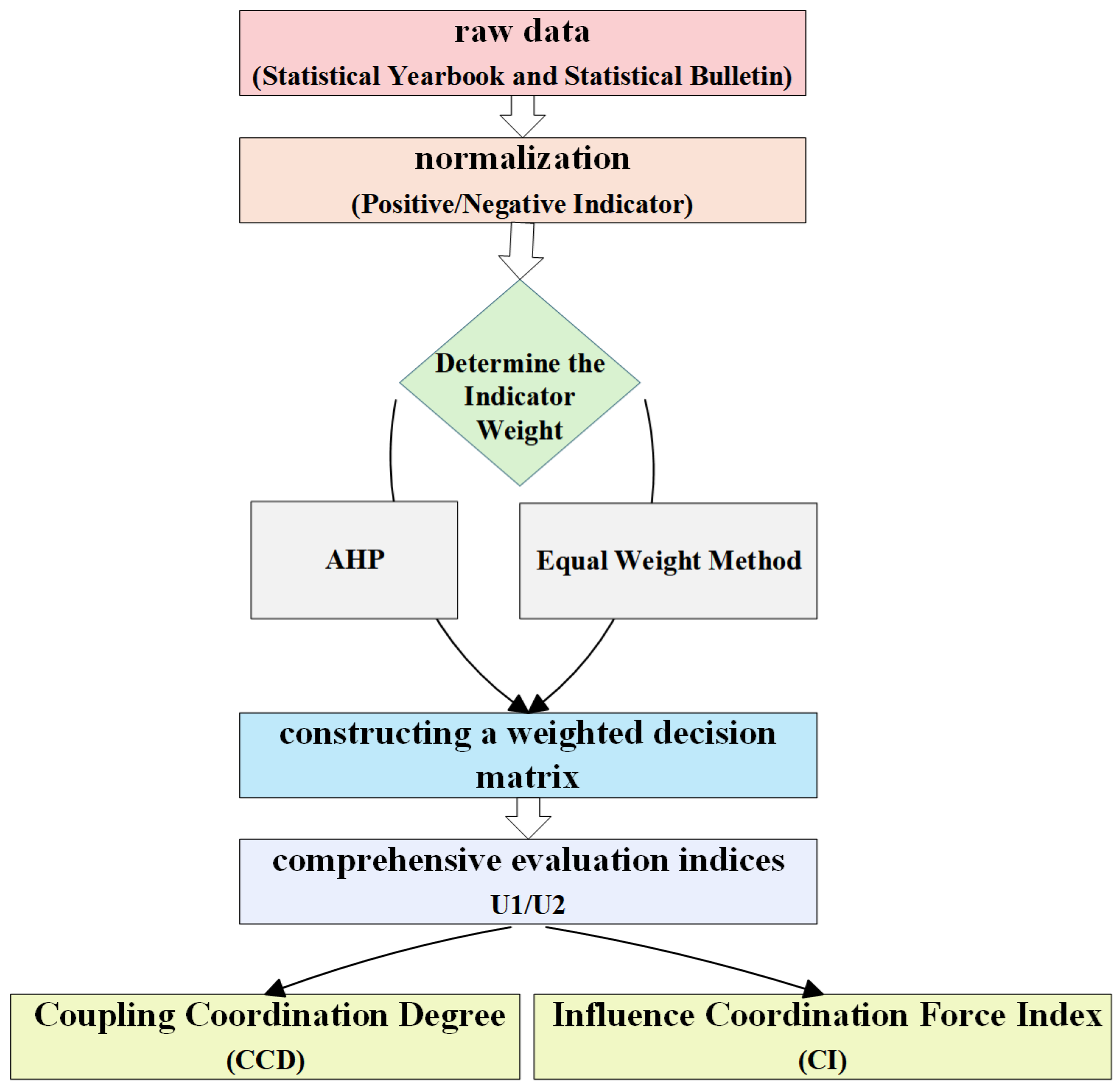
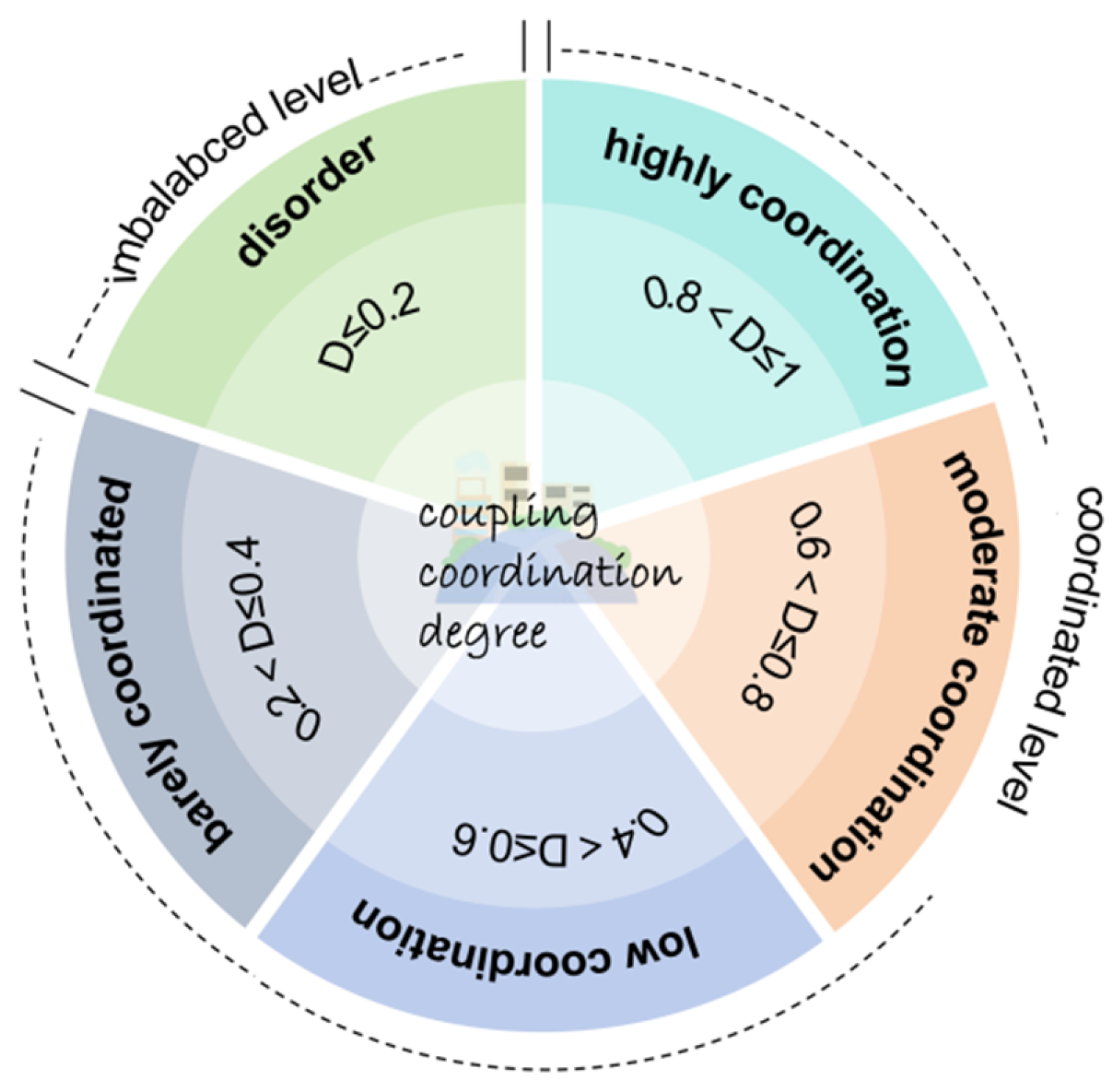


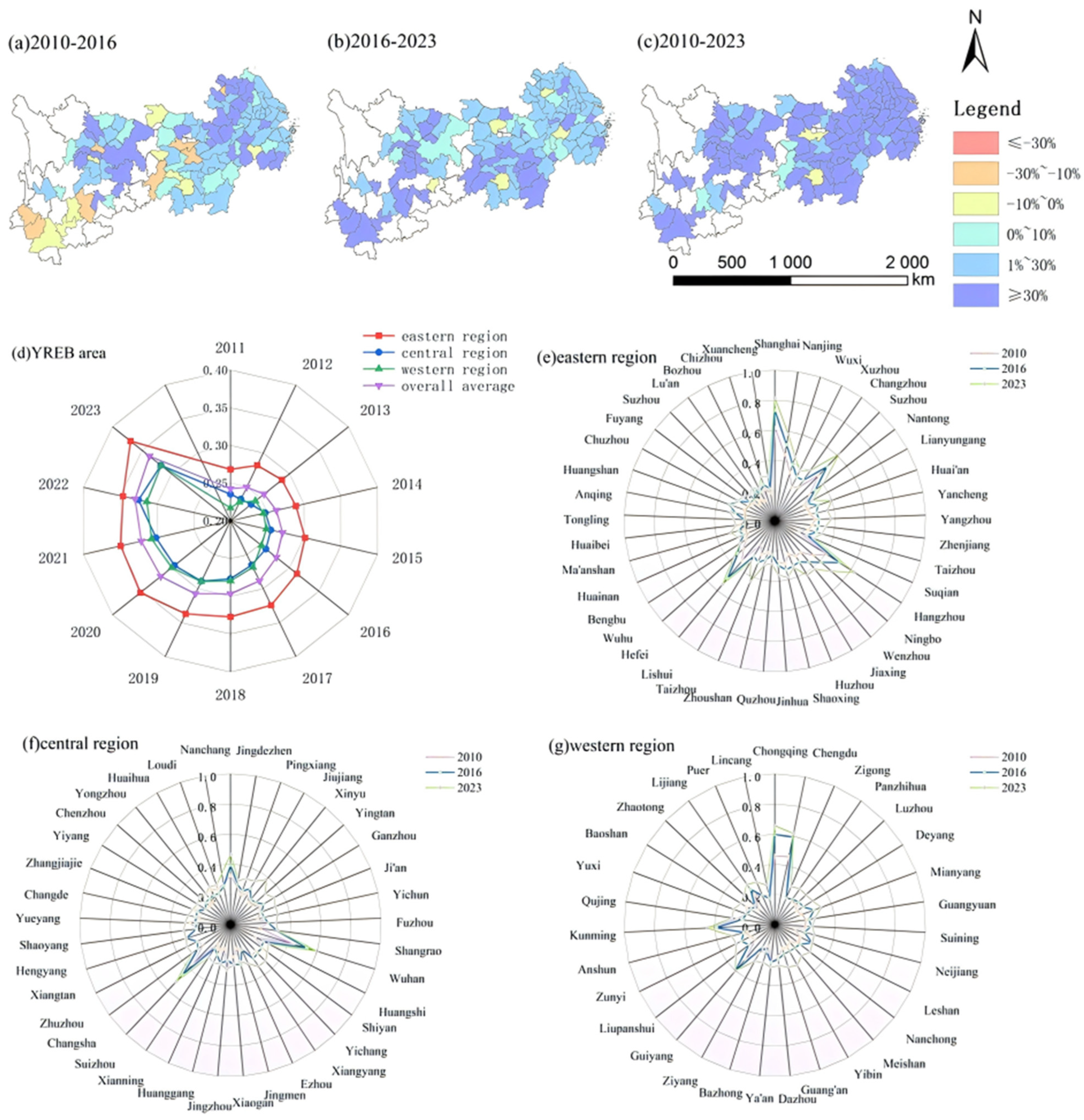



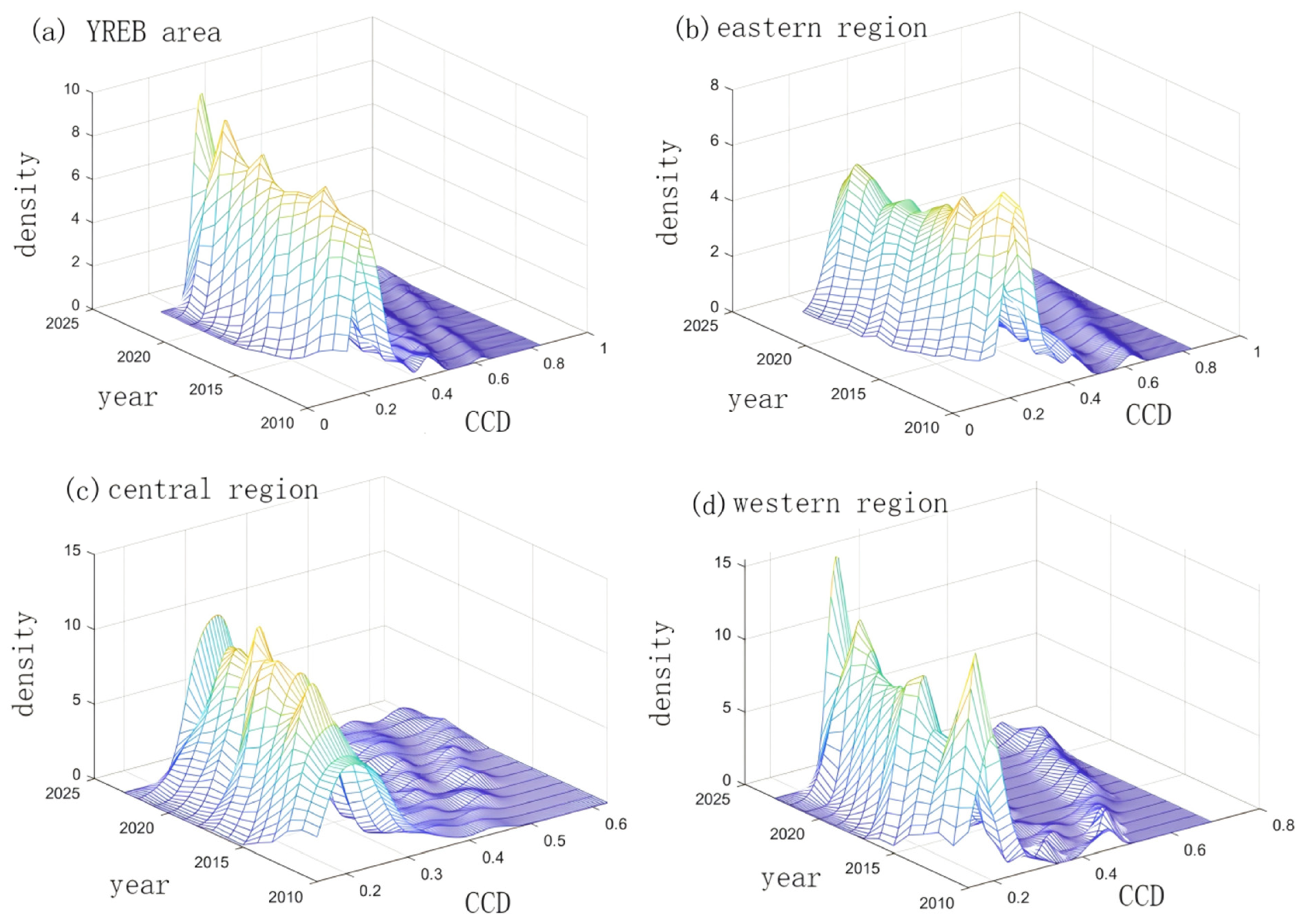
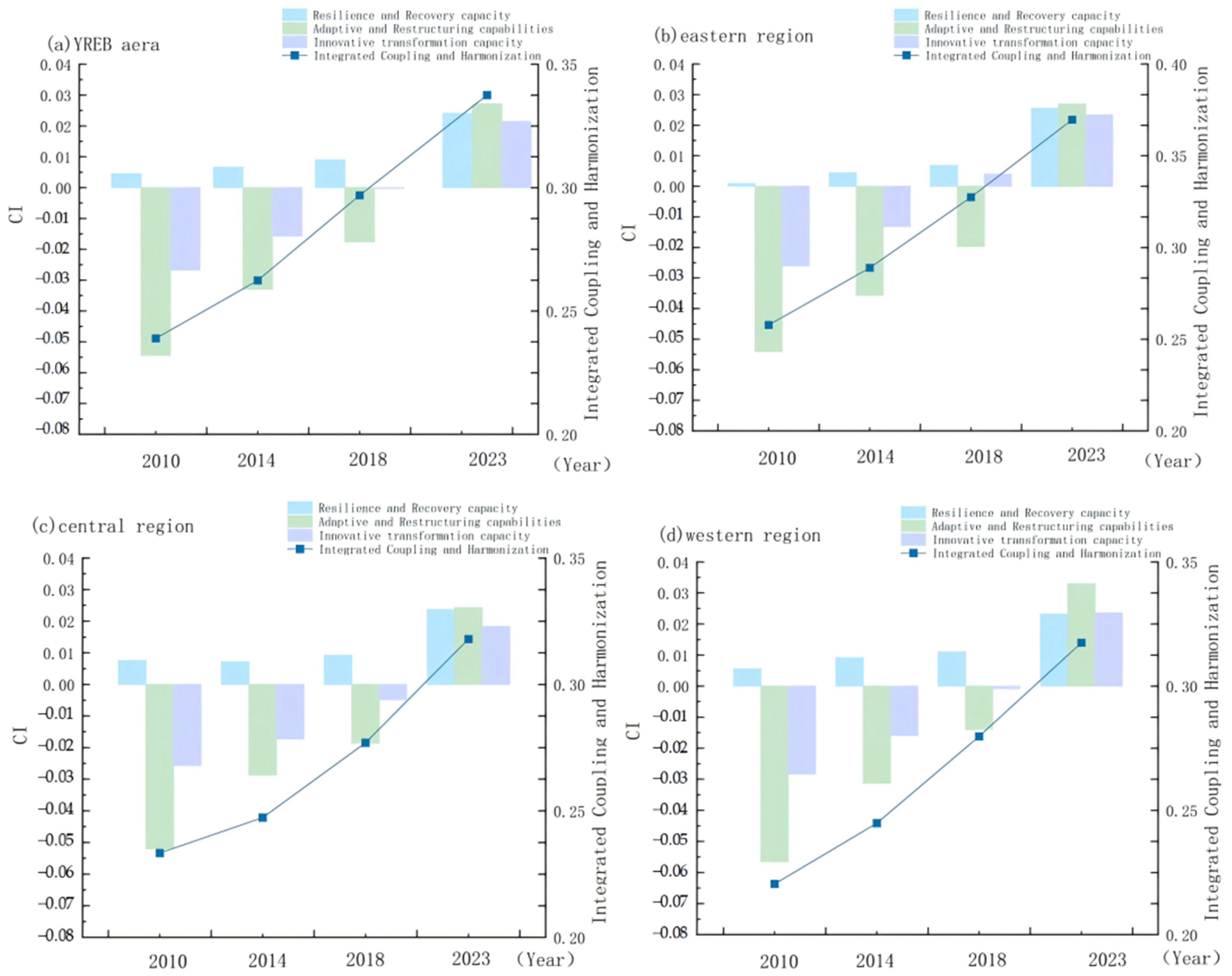
| Target Level | Standardized Layer | Weights | Factor Layer | Definition | Weights | Causality |
|---|---|---|---|---|---|---|
| ER | Resilience and Recovery | 0.1162 | GDP per capita/billion dollars | Gross Regional Product divided by the total population at the end of the year, measuring the level of economic development | 0.0618 | + |
| Urban registered unemployment rate/% | The proportion of registered urban unemployed population to the urban employed population, measuring employment stability | 0.0010 | - | |||
| GDP growth rate/% | The percentage growth of GDP in the current year compared with the previous year, measuring the driving force of economic growth | 0.0047 | + | |||
| Foreign trade dependence/% | The proportion of total import and export volume to GDP, measuring the exposure degree of export-oriented economic risks | 0.0024 | - | |||
| Disposable income per capita/$ | Disposable income of residents divided by the population, measuring residents’ purchasing power and the foundation of economic resilience | 0.0406 | + | |||
| Adaptive and restructuring | 0.5939 | Level of financial self-sufficiency/% | The proportion of local fiscal general budget revenue to expenditure, measuring fiscal autonomy | 0.0315 | + | |
| Total sales of social retail goods/million dollars | Total retail sales of social consumer goods, measuring market consumption vitality and economic stability | 0.1375 | + | |||
| Investment in fixed assets/million dollars | Total fixed asset investment of the whole society, measuring economic growth potential and risk resistance capacity | 0.0893 | + | |||
| Number of health facility beds per capita/(beds per 10,000 persons) | Number of beds in health institutions divided by the population, measuring public service and crisis response capacity | 0.1223 | + | |||
| RMB deposits in financial institutions/$10,000 | Balance of deposits in local and foreign currencies of financial institutions, measuring regional capital reserves and risk-resistant buffer capacity | 0.2174 | + | |||
| Innovative transformation | 0.2899 | Number of patent applications/piece | Annual number of authorized patent applications, measuring regional innovation capacity and the level of technological progress | 0.2252 | + | |
| Urbanization rate/% | The proportion of urban population to the total population, measuring regional urbanization and the level of economic structure transformation | 0.0147 | + | |||
| Internet penetration rate/% | The proportion of Internet users to the total population, measuring the development level of the digital economy | 0.0433 | + | |||
| Degree of advanced industrial structure/% | The proportion of the output value of the tertiary industry to GDP, measuring the level of industrial structure optimization | 0.0084 | + |
| Target Level | Standardized Layer | Weights | Factor Layer | Definition | Weights | Causality |
|---|---|---|---|---|---|---|
| HQTD | Innovative development | 0.2501 | Tourism patent authorizations/unit | Number of authorized patents in tourism-related industries (e.g., smart tourism, green tourism technology), measuring tourism innovation capacity | 0.0675 | + |
| Annual large-scale tourism Festivals and exhibitions/event | Annual number of national/provincial tourism festivals and exhibition activities, measuring tourism industry vitality and brand influence | 0.0238 | + | |||
| Online booking coverage for 4A-rated and above scenic areas/% | The proportion of 4A-level and above scenic spots that support online booking, measuring the level of tourism digital services | 0.1045 | + | |||
| Activity level of tourism-related digital platforms | Comprehensive index of tourism APP downloads and online reviews, etc., measuring the penetration level of tourism digitalization | 0.0543 | + | |||
| Coordinated development | 0.0800 | Tourism revenue as a percentage of GDP/% | The proportion of total tourism revenue to the gross regional product, measuring the contribution of the tourism economy | 0.0155 | + | |
| Tourism revenue as a percentage of tertiary industry/% | The proportion of total tourism revenue to the output value of the tertiary industry, measuring the driving effect of tourism on the service industry | 0.0155 | + | |||
| Ratio of domestic to inbound tourist visits | The ratio of domestic tourist arrivals to inbound tourist arrivals, measuring the internationalization level of the tourism market | 0.0057 | - | |||
| Rural-urban tourism revenue ratio | The ratio of urban tourism revenue to rural tourism revenue, measuring the urban-rural balance of tourism development | 0.0037 | - | |||
| Ratio of tourism beds to annual visitor volume | The ratio of the number of hotel rooms/beds to the total annual number of tourists received, measuring the matching degree of tourism reception capacity | 0.009 | + | |||
| Spatial aggregation of tourism industry | Geographic concentration index of tourism enterprises (e.g., EG index), measuring the level of tourism industry clustering | 0.0306 | + | |||
| Green development | 0.4198 | Park green space per capita/m2 | Total area of park green space divided by the population, measuring the quality of the tourism ecological environment | 0.0486 | + | |
| Proportion of nature reserves and scenic areas to total land area/% | The proportion of ecologically protected area to the administrative area, measuring the sustainable utilization level of tourism resources | 0.0445 | + | |||
| Ratio of days with good air quality/% | The proportion of days with good air quality in a year, measuring the support capacity of the ecological environment for tourism | 0.1575 | + | |||
| Municipal wastewater treatment rate/% | The proportion of urban sewage treatment volume to the total sewage discharge, measuring the environmental protection level of tourism infrastructure | 0.0846 | + | |||
| Non-hazardous treatment rate of domestic waste/% | The proportion of harmless treatment of domestic waste to the total amount, measuring the environmental governance capacity of tourism destinations | 0.0846 | + | |||
| Open development | 0.1000 | Inbound tourism revenue as a percentage of total tourism revenue/% | The proportion of inbound tourism revenue to total tourism revenue, measuring the internationalization level of tourism | 0.0274 | + | |
| International tourism foreign exchange earnings/US$ million | Foreign exchange income generated by inbound tourists’ consumption in the country, measuring the international market competitiveness of tourism | 0.0157 | + | |||
| Number of international air routes/routes | The number of regular international routes connecting domestic and foreign cities, measuring the convenience and openness of tourism transportation | 0.0467 | + | |||
| Number of star-rated hotels or restaurants/hotels | Total number of hotels from five-star to one-star, measuring the quality of tourism reception services and the level of facilities | 0.0102 | + | |||
| Shared development | 0.1501 | Number of tourism industry employees/10,000 people | Number of direct tourism employees, measuring the driving effect of the tourism industry on employment | 0.0249 | + | |
| Tourism revenue as a percentage of urban and rural residents’ income/% | The proportion of total tourism revenue to the disposable income of urban and rural residents, measuring the contribution of tourism to residents’ income | 0.0402 | + | |||
| Investment in fixed assets in tourism/million dollars | Investment in fixed assets related to tourism, such as scenic spots, hotels and transportation, measuring the development potential of the tourism industry | 0.0143 | + | |||
| Road mileage/km | Total mileage of graded highways in the country, measuring the accessibility of tourism transportation | 0.0092 | + | |||
| Citizen satisfaction with local tourism environment (%) | Citizens’ satisfaction score (1–5 points) with tourism infrastructure, service quality and ecological environment | 0.0615 | + |
Disclaimer/Publisher’s Note: The statements, opinions and data contained in all publications are solely those of the individual author(s) and contributor(s) and not of MDPI and/or the editor(s). MDPI and/or the editor(s) disclaim responsibility for any injury to people or property resulting from any ideas, methods, instructions or products referred to in the content. |
© 2025 by the authors. Licensee MDPI, Basel, Switzerland. This article is an open access article distributed under the terms and conditions of the Creative Commons Attribution (CC BY) license (https://creativecommons.org/licenses/by/4.0/).
Share and Cite
Zhang, C.; Wu, X.; Hu, B.; Ma, D.; Huang, J.; Hu, C.; Zhang, F. A Study on the Coupling and Coordination Between Urban Economic Resilience and High-Quality Development of Tourism in the Yangtze River Economic Belt. Sustainability 2025, 17, 9657. https://doi.org/10.3390/su17219657
Zhang C, Wu X, Hu B, Ma D, Huang J, Hu C, Zhang F. A Study on the Coupling and Coordination Between Urban Economic Resilience and High-Quality Development of Tourism in the Yangtze River Economic Belt. Sustainability. 2025; 17(21):9657. https://doi.org/10.3390/su17219657
Chicago/Turabian StyleZhang, Chuanhua, Xueci Wu, Beiming Hu, Dalai Ma, Jiaxin Huang, Chao Hu, and Fengtai Zhang. 2025. "A Study on the Coupling and Coordination Between Urban Economic Resilience and High-Quality Development of Tourism in the Yangtze River Economic Belt" Sustainability 17, no. 21: 9657. https://doi.org/10.3390/su17219657
APA StyleZhang, C., Wu, X., Hu, B., Ma, D., Huang, J., Hu, C., & Zhang, F. (2025). A Study on the Coupling and Coordination Between Urban Economic Resilience and High-Quality Development of Tourism in the Yangtze River Economic Belt. Sustainability, 17(21), 9657. https://doi.org/10.3390/su17219657


_Li.png)



